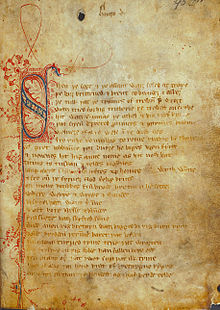Sir Gawain and the Green Knight
Sir Gawain and the Green Knight (Middle English: Sir Gawayn and þe Grene Knyȝt) is a late 14th-century Middle English chivalric romance. It is one of the most notable Arthurian stories. It is known as the "beheading game". The story is written in stanzas of alliterative verse. Each stanza ends in a rhyming bob and wheel.[1]

Plot
changeAt a New Year's Day feast in Camelot, a huge green man rides in on a green horse carrying a large axe. He issues a challenge to any who dares to accept. He challenges any knight to strike him with his axe, if he will take a return blow in a year and a day.
Sir Gawain, a knight of King Arthur's Round Table, accepts the challenge. Gawain beheads the Green Knight with his blow. Then the Green knight stands up and picks up his head. He says:
- "Take heed, Sir Gawain, that thou art ready to go and seek me till thou find me as thou hast promised in this hall with these knights as witnesses. To the green chapel thou shalt come to receive such a blow as thou hast given, on New Year's morning. And many know me as the Knight of the Green Chapel. Fail not, then, to seek me until thou findest me; therefore come thou, or recreant shalt thou be called". transl. Ernest J. B. Kirtlan. [1]
Having reminded Gawain of the appointed time, the Green Knight rides off. In his struggles to keep his bargain, Gawain sets off on his search. His honour is called into question several times. Gawain avoids several trials on his way. Finally he meets the Lady Bertilak, who tries to seduce him. He avoids this, but accepts a gift from her. He is bound to give the gift back to his host (who actually is the Green Knight in another form). When the day comes for the Green Knight to strike, Gawain kneels... When the Green Knight strikes, he nicks Gawain's neck, but otherwise Gawain is unhurt. The Green Knight explains that the nick is payment for Gawain's only fault, keeping the small gift.
The Green Knight is thought by some to be the Green Man of folklore, and by others to represent Satan.
References
change- ↑ Simpson, James. 2008. A note on Middle English meter, in Sir Gawain and the Green Knight (a new verse translation) by Simon Armitage. Norton, p. 18.
Other websites
change| Definitions from Wiktionary | |
| News stories from Wikinews | |
| Quotations from Wikiquote | |
| Source texts from Wikisource | |
| Learning resources from Wikiversity | |
- Online texts
- High-resolution, full-sized scan of entire manuscript Archived 2014-11-12 at the Wayback Machine
- Sir Gawain and the Green Knight at Archive.org
- The poem in Middle English
- Various free audiobook versions of the poem from LibriVox
- Google Books results
- General information
- The Gawain/Pearl Poet from the University of Calgary
- The Camelot Project Info on Sir Gawain Archived 2007-10-11 at the Wayback Machine
- Luminarium SGGK Website
- Oxford Bibliographies: Bibliography on Sir Gawain and the Green Knight
- BBC documentary tour of locations thought to be found in the poem... Holywell, the River Mersey, the 'Wild Wirral', the Peak District, the Roaches, and Lud Chapel